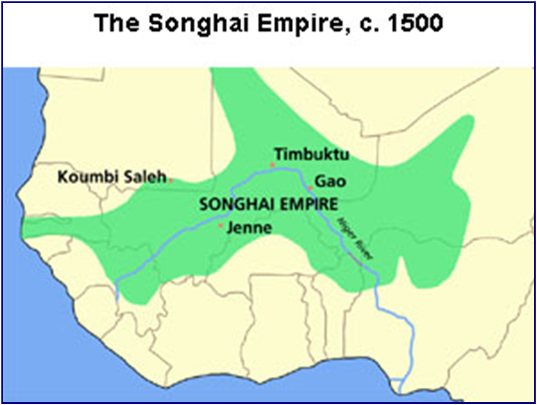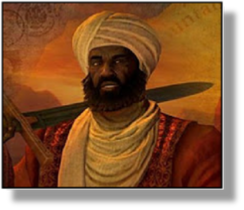


THE SONGHAI EMPIRE -
xxxxxIt was in the latter part of the fourteenth century that the Songhai Empire of West Africa, once overshadowed by its powerful Mali neighbour, began to re-
xxxxxUnder his  successor, Askia Muhammad I, the Songhai reached the height of their power and influence. The full extent of his territorial gains is not clear, but it is said that “by fire and sword” he carved out an empire that, at its height, included parts of modern Guinea, Senegal, Mali, Mauritania, Niger and the Hausa states of Nigeria, conquered in 1512. What is clear is that he had a remarkable flair for effective administration. He divided the empire into a number of provinces, each with a governor, and appointed directors to deal with specific state affairs, such as finance, agriculture, and justice. Under his leadership Timbuktu became a thriving cultural centre once more, and Islam was made the official religion of the ruling classes. As we have seen, his pilgrimage to Mecca, made in 1496 (H7), testified to the efficiency of his state as well as to the wealth of his empire.
successor, Askia Muhammad I, the Songhai reached the height of their power and influence. The full extent of his territorial gains is not clear, but it is said that “by fire and sword” he carved out an empire that, at its height, included parts of modern Guinea, Senegal, Mali, Mauritania, Niger and the Hausa states of Nigeria, conquered in 1512. What is clear is that he had a remarkable flair for effective administration. He divided the empire into a number of provinces, each with a governor, and appointed directors to deal with specific state affairs, such as finance, agriculture, and justice. Under his leadership Timbuktu became a thriving cultural centre once more, and Islam was made the official religion of the ruling classes. As we have seen, his pilgrimage to Mecca, made in 1496 (H7), testified to the efficiency of his state as well as to the wealth of his empire.
xxxxxMuhammad’s fall from power was a tragic one. In 1528 the great leader was overthrown by his eldest son Musa, and banished to a mosquito-
tragic one. In 1528 the great leader was overthrown by his eldest son Musa, and banished to a mosquito-
xxxxxDue in no small way to the sound administrative system established by Muhammad (illustrated above), the Songhai remained the dominant force in the area for some years after his death, but bitter disputes over the succession and an increasing number of raids from neighbouring states greatly weakened the empire. As we shall see, the end came in 1591 (L1) with the coming of the Moroccan army, equipped with firearms and bent on conquest.
xxxxxThe Songhai Empire of West Africa began to grow in strength towards the end of the 14th century. As we have seen, on coming to power in 1464 (E4), its able leader Sunni Ali captured Timbuktu, restored the lucrative trans-



Acknowledgements
Map (West Africa): licensed under Creative Commons. User: Roke -
H8-